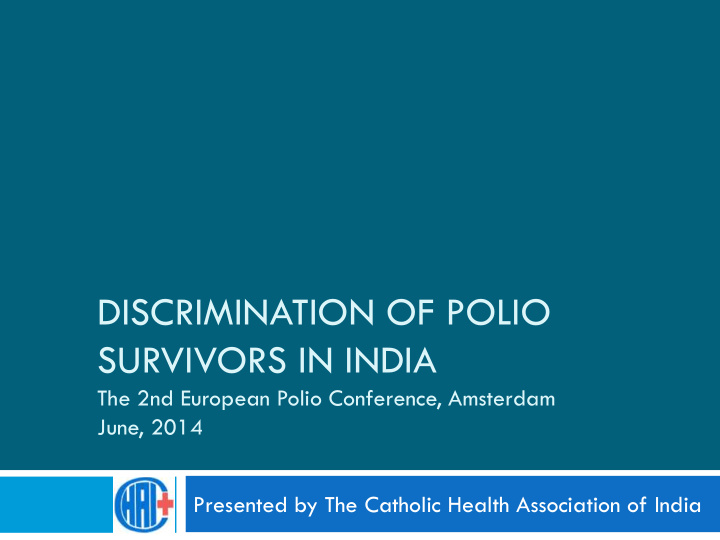



DISCRIMINATION OF POLIO SURVIVORS IN INDIA The 2nd European Polio Conference, Amsterdam June, 2014 Presented by The Catholic Health Association of India
Introduction India celebrated its three year anniversary of being a polio free nation Polio is often thought of as synonymous with paralysis and disability. One of the leading causes of physical disability in India Persons with disabilities are one of the most oppressed, marginalised and stigmatized groups In the Indian context; cultural and religious beliefs are so deeply imbedded that they have an effect on the attitudes of the society at large
Understanding Stigma and Discrimination Concept of stigma dates back to the time of Greeks where it was conceptualised as bodily signs which are unusual or different (Goffmann,1963) Stigma is looked at a broader sense where it goes beyond a physical mark and involves attributes that leads to widespread social disapproval Stigma not only occurs in social interactions but also resides within the social context
Polio is one of the conditions that is Enacted Stigma: perceived to be stigmatized Discriminatory experiences from societal reactions Labelling process leads to enacted stigma and felt stigma Felt Stigma: Discriminatory experiences from Persons affected with polio imagined social stigmatised due to the reactions accompanying disabilities caused by the disease
Stigma and the Indian context Influence of religious beliefs creates further stigmatisation Considered as a ‘flaw’ or lacking something Concept of karma: repaying for previous sins committed Looked upon as eternal childhood which further emphasizes dependency and reinforces the charity/pity model Rights of polio survivors thus grossly neglected
Multiple discrimination Trap Disability a social construct when combined with other social constructs such as gender, caste, ethnicity leads to multiple discrimination Further leads to denied access of education, employment and maintaining social relationships Fosters low self esteem, increases vulnerability, low literacy level and furthers experiences of neglect within their own families Creation of physical and attitudinal barriers and thereby denying access to basic rights.
Stigma of polio survivors: Study A study adopting a mixed approach Polio Survivor Definition : Persons affected by polio who have a lifelong disability Conducted among 30 polio survivors located in the rural areas of Mahaboobnagar district of Telangana state in India The quantitative aspect was done using the Participation scale developed by ILEP to get a quantitative measure of perceived participation restrictions. The qualitative aspect involved in-depth interviews among 10 participants.
Stigma of polio survivors: Study A set of 18 structured questions were asked which dealt with participation in various aspects : Work Social interaction Recreational activities Social relationships Decision making Participation within the household
Stigma of polio survivors: Study The scale involved two parts. Initially the participants were asked if they faced issues in participation in different aspects. Followed by rating of issues where scores were assigned. The larger the issue, a higher score was assigned and vice versa.
Findings: Demographic details Half of the participants belonged to the age bracket of 20 – 40 years while the remaining between 40-60 years. Half of the respondents were male participants while the remaining half comprised of females All the participants belonged to economically backward families.
Findings: Participation 40% of the participants stated to face severe restriction across all spheres of their life More than half of them were women polio survivors Related to the multiple discrimination aspect wherein gender and disability play a role in stigma and discrimination. Around 33% were stated to face moderate restriction while 23% faced mild restriction in terms of participation
Findings: Participation Higher restriction faced in participation of recreational activities Other areas include : within the workspace, social interaction in public places and limitations in doing household work Least score was given to the area where participants were asked about their confidence in learning new things
Findings: Participation Restrictions not only due to their physical limitations but also due to the inaccessibility of the environment. Highlights that public places are built keeping the majority able bodied persons in mind thus not catering to the requirements of those having limitations Polio survivors still faced difficulties in the area of social relationships particularly marriage Younger generation faced lesser restriction across different spheres as compared to their older counterparts
Conclusion Important to not ignore those persons who have been afflicted with the disease and are living with a disability There is a need to include programmes which ensure rehabilitation and mainstream the polio survivors into the society Though India is a signatory of the United Nations Convention on Rights of Persons with Disabilities, majority of the efforts remain on paper
Conclusion Some of the major aspects that require focus: Increase in co-ordination between the various departments and ministries Inclusion of disability agenda across various sectors of health, education, labour, recreation etc Increase in awareness among the public about the rights of persons with disabilities
Conclusion Sensitisation and capacity building of health care workers towards persons with disabilities Multi stakeholder participation which involves persons with disabilities, caregivers, bureaucrats, technocrats, corporates, government organisations and media in the disability rights movement
Thank You!
Recommend
More recommend